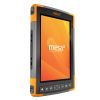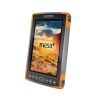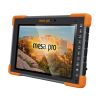Juniper Geode GNSS Receivers
The Juniper Geode is a simple GNSS solution that collects real-time sub-meter data accurately in harsh environments.
Features
- Compatible with iOS, Android, and Windows devices
- Intuitive and easy operation, one-button simplicity
- All day battery life for long work days in the field
- Free ground shipping
- Expedited repair and warranty service
- Lifetime technical support
- More
Overview
The Juniper Geode offers a simple and scalable sub-meter, sub-foot, decimeter, and centimeter GNSS solution at an affordable price. Designed with versatility in mind, the Geode works well with most Apple, Windows, and Android devices. An integrated antenna makes messy cables a thing of the past, yet still has an external antenna port if it’s needed. Take the Geode mounted on a pole, in a pack, or in hand to collect real-time precision GNSS data wherever the job takes you.
Benefits
- Scalable Accuracy - Collect precision multi-frequency, multi-constellation GNSS data at various accuracy levels
- Worldwide Corrections - Multiple correction sources provide precise, real-time data
- Compact Size - Small and lightweight for all-day use
- Open Interface - Works with Juniper Systems' handhelds or your own device
- Simple to Use - Intuitive and easy operation, one-button simplicity
- All-Day Battery Life - Ideal for long work days
- (1) Geode GNSS receiver with integrated antenna and battery
- (1) USB Type-A to USB Type-C cable
- (1) USB Type-C to USB Type-C cable
- (1) 5/8 x 11 pole mount adapter
- (1) USB charger
In The News
Combating Water Insecurity in Saskatchewan with Real-Time Data
The prairies of Saskatchewan can be described as one of the least water-secure parts of Canada, making water quality monitoring essential for informed resource management in a region already facing water insecurity. While natural physical properties worsen some of the poor water quality conditions in the region, others are connected to land use. Having grown up spending summers on the shores of Lake Huron, Helen Baulch, an associate professor at the School of Environment and Sustainability at the University of Saskatchewan , has always been dedicated to the protection of water resources. Looking back fondly at her childhood playing along the shore, Baulch also recalls the invasion of quagga mussels during her teenage years and watching the lake change as a result.
Read MoreSeametrics Turbo Turbidity Logger: Boost your Turbidity Monitoring
The Seametrics Turbo Turbidity Logger is a self-cleaning turbidity sensor capable of internally logging over 260,000 data records. The sensor enables researchers, compliance officers, and contractors to monitor turbidity in various applications, from construction and dredging sites to wastewater effluent. Due to its narrow width, this device can be deployed in a range of areas, from small well spaces to rivers and streams. The stainless steel housing and built-in wiper allow the sensor to withstand long-term deployments and reduce the need for maintenance trips. The logger accurately records temperature and turbidity up to a depth of 50 meters.
Read MoreCollecting Data at the Top of the World: How Scientists Retrieve Glacial Ice Cores
A helicopter touches down in the small town of Sicuani, Peru, at an elevation of 11,644 feet. Earlier that day, a boxcar brought fuel, drills, food, and other equipment for a glacial expedition. The year is 1979, and glaciologist Lonnie Thompson is preparing to lead a team to the Quelccaya ice cap in hopes of becoming the first scientists to drill an ice core sample from this glacier. The only problem? The glacier is located at 19,000 feet in one of the most remote areas of the world. The helicopter takes off from the town, but the thin atmosphere at that elevation does not allow it to safely touch down on the ice– due to the aircraft’s weight, and it becomes unstable when the air is less dense.
Read More



































